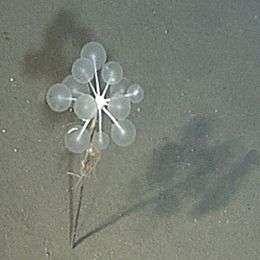Chondrocladia
Chondrocladia is a genus of carnivorous demosponges of the family Cladorhizidae.[3] Neocladia was long considered a junior synonym, but has recently become accepted as a distinct genus.[4]
| Chondrocladia Temporal range: Pleistocene? to Present | |
|---|---|
 | |
| The ping-pong tree sponge, Chondrocladia lampadiglobus [1][2] | |
| Scientific classification | |
| Kingdom: | Animalia |
| Phylum: | Porifera |
| Class: | Demospongiae |
| Order: | Poecilosclerida |
| Family: | Cladorhizidae |
| Genus: | Chondrocladia Thomson, 1873 |
| Species | |
|
33; see text | |
| Synonyms | |
| |
33 named species are placed in this genus at present, but at least two additional undescribed ones are known to exist, while some of the described ones are known only from a few specimens or (e.g. the enigmatic Chondrocladia occulta) just a single one, and their validity and/or placement in Chondrocladia is doubtful. Chondrocladia sponges are stipitate, with a stalk frequently anchored in the substrate by rhizoids and an egg-shaped body, sometimes with branches that end in inflatable spheres.[5][6]
Fossils assignable to this genus are known since the Pleistocene,[7] less than 2 million years ago. But given its deep sea habitat, Chondrocladia may well have been around for much longer – perhaps since the Mesozoic, as characteristic spicules (termed "microcricorhabds" or "trochirhabds"), almost identical to those of some living Chondrocladia, are known from Early Jurassic rocks almost 200 million years old.[6]
Carnivory
These sponges gained media attention when a new species, a gourd-shaped carnivorous sponge, was featured in reports of finds off the coast of Antarctica. The new Chondrocladia was one of 76 sponge species identified in the seas off Antarctica by the Antarctic Benthic Deep-Sea Biodiversity Project (ANDEEP) between 2002 and 2005, conducted aboard the German research vessel Polarstern.[8][9]
Carnivorous sponges, which use hooked spicules to capture small crustaceans, have been known only since 1995, when Asbestopluma hypogea, another genus of the family Cladorhizidae, was identified in Mediterranean sea caves offshore La Ciotat (France) by Jean Vacelet and Nicole Boury-Esnault.[10] Carnivory has since turned out to be common and typical for this sponge family.[11][4] Unlike their relatives, Chondrocladia still possesses the water flow system and choanocytes typical of sponges, albeit highly modified to inflate balloon-like structures that are used for capturing prey.[4][6]
Species
The known species of Chondrocladia are:[6][3]
|
|
C. alaskensis and C. pulchra are better placed in Crambe[5] or Monanchora.[3]
C. dura, C. ramosa and C. sessilis are junior synonyms of Iotrochota purpurea.[3]
C. flabelliformis is now in Neocladia.[4][3]
References
-
- Vacelet, J. (2006). New carnivorous sponges (Porifera, Poecilosclerida) collected from manned submersibles in the deep Pacific. Zoological Journal of the Linnean Society 148: 553–584. Figure 17. doi:10.1111/j.1096-3642.2006.00234.x
- Van Soest, R. W. M., Boury-Esnault, N., Vacelet, J., Dohrmann, M., Erpenbeck, D., De Voogd, N. J., Santodomingo, N., Vanhoorne, B., Kelly, M., Hooper, J. N. A. (2011). Global Diversity of Sponges (Porifera). PLoS ONE 7(4): e35105. Figure 3. doi:10.1371/journal.pone.0035105
- van Soest, R. (2014). Van Soest RW, Boury-Esnault N, Hooper JN, Rützler K, de Voogd NJ, de Glasby BA, Hajdu E, Pisera AB, Manconi R, Schoenberg C, Janussen D, Tabachnick KR, Klautau M, Picton B, Kelly M, Vacelet J (eds.). "Chondrocladia Thomson, 1873". World Porifera database. World Register of Marine Species. Retrieved 2014-04-30.
- Vacelet, Jean (2008). "A new genus of carnivorous sponges (Porifera: Poecilosclerida, Cladorhizidae) from the deep N-E Pacific, and remarks on the genus Neocladia" (PDF). Zootaxa. 1752: 57–65.
- Cristobo, Francisco Javier; Urgorri, Victoriano; Ríos, Pilar (2005). "Three new species of carnivorous deep-sea sponges from the DIVA-1 expedition in the Angola Basin (South Atlantic)". Organisms Diversity & Evolution. 5 (Supplement 1): 203–213. doi:10.1016/j.ode.2004.11.004.
- Vacelet, Jean; Kelly, Michelle (September 25, 2008). "New species from the deep Pacific suggest that carnivorous sponges date back to the Early Jurassic" (PDF). Nature Precedings. hdl:10101/npre.2008.2327.1. Archived from the original (PDF) on July 14, 2011.
- Sepkoski, J. John, Jr. (2002). "A compendium of fossil marine animal genera". Bulletins of American Paleontology. 364: 560.
- Brandt, Angelika; Gooday, Andrew J.; Brandão, Simone N.; Brix, Saskia; Brökeland, Wiebke; Cedhagen, Tomas; Choudhury, Madhumita; Cornelius, Nils; Danis, Bruno; De Mesel, Ilse; Diaz, Robert J.; Gillan, David C.; Ebbe, Brigitte; Howe, John A.; Janussen, Dorte; Kaiser, Stefanie; Linse, Katrin; Malyutina, Marina; Pawlowski, Jan; Raupach, Michael; Vanreusel, Ann (17 May 2007). "First insights into the biodiversity and biogeography of the Southern Ocean deep sea". Nature. 447 (7142): 307–311. doi:10.1038/nature05827. PMID 17507981.
- Scales, Helen (May 16, 2007). "Bizarre new deep-sea creatures found off Antarctica". National Geographic News. Retrieved May 17, 2007.
- Vacelet, Jean; Boury-Esnault, N. (1995). "Carnivorous sponges". Nature. 373 (6512): 333–335. doi:10.1038/373333a0.
- Watling, Les (2007). "Predation on copepods by an Alaskan cladorhizid sponge". Journal of the Marine Biological Association of the UK. 87 (6): 1721–1726. doi:10.1017/S0025315407058560.